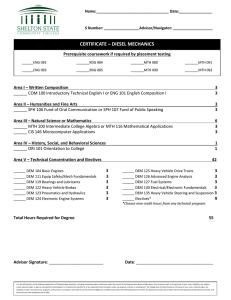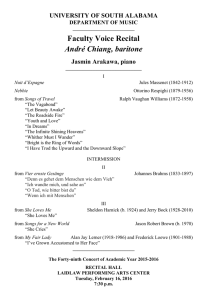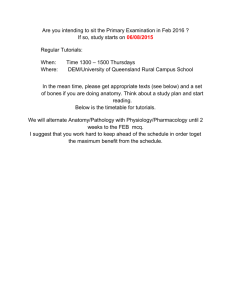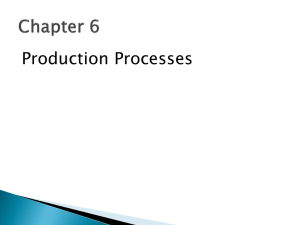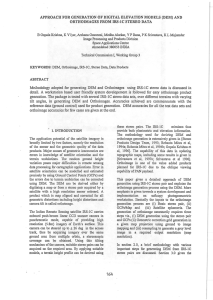Evaluation of Cartosat-I Stereo Data of Rome , K.Kalyanaraman, K.Radhakrishnan
advertisement
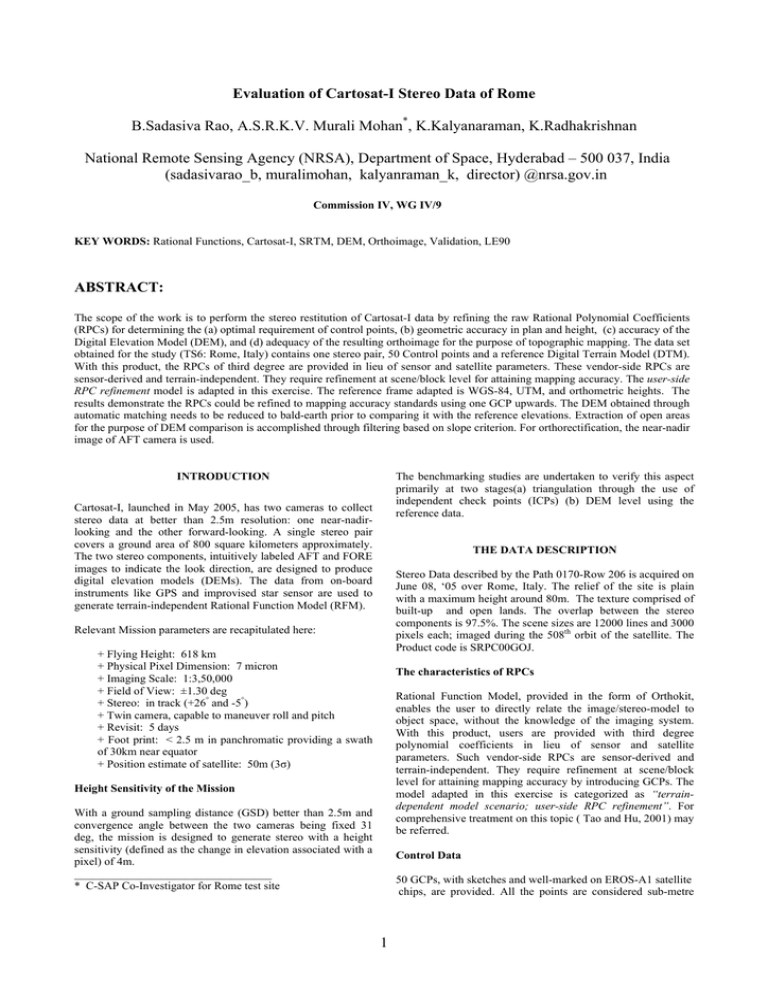
Evaluation of Cartosat-I Stereo Data of Rome
B.Sadasiva Rao, A.S.R.K.V. Murali Mohan*, K.Kalyanaraman, K.Radhakrishnan
National Remote Sensing Agency (NRSA), Department of Space, Hyderabad – 500 037, India
(sadasivarao_b, muralimohan, kalyanraman_k, director) @nrsa.gov.in
Commission IV, WG IV/9
KEY WORDS: Rational Functions, Cartosat-I, SRTM, DEM, Orthoimage, Validation, LE90
ABSTRACT:
The scope of the work is to perform the stereo restitution of Cartosat-I data by refining the raw Rational Polynomial Coefficients
(RPCs) for determining the (a) optimal requirement of control points, (b) geometric accuracy in plan and height, (c) accuracy of the
Digital Elevation Model (DEM), and (d) adequacy of the resulting orthoimage for the purpose of topographic mapping. The data set
obtained for the study (TS6: Rome, Italy) contains one stereo pair, 50 Control points and a reference Digital Terrain Model (DTM).
With this product, the RPCs of third degree are provided in lieu of sensor and satellite parameters. These vendor-side RPCs are
sensor-derived and terrain-independent. They require refinement at scene/block level for attaining mapping accuracy. The user-side
RPC refinement model is adapted in this exercise. The reference frame adapted is WGS-84, UTM, and orthometric heights. The
results demonstrate the RPCs could be refined to mapping accuracy standards using one GCP upwards. The DEM obtained through
automatic matching needs to be reduced to bald-earth prior to comparing it with the reference elevations. Extraction of open areas
for the purpose of DEM comparison is accomplished through filtering based on slope criterion. For orthorectification, the near-nadir
image of AFT camera is used.
The benchmarking studies are undertaken to verify this aspect
primarily at two stages(a) triangulation through the use of
independent check points (ICPs) (b) DEM level using the
reference data.
INTRODUCTION
Cartosat-I, launched in May 2005, has two cameras to collect
stereo data at better than 2.5m resolution: one near-nadirlooking and the other forward-looking. A single stereo pair
covers a ground area of 800 square kilometers approximately.
The two stereo components, intuitively labeled AFT and FORE
images to indicate the look direction, are designed to produce
digital elevation models (DEMs). The data from on-board
instruments like GPS and improvised star sensor are used to
generate terrain-independent Rational Function Model (RFM).
THE DATA DESCRIPTION
Stereo Data described by the Path 0170-Row 206 is acquired on
June 08, ‘05 over Rome, Italy. The relief of the site is plain
with a maximum height around 80m. The texture comprised of
built-up and open lands. The overlap between the stereo
components is 97.5%. The scene sizes are 12000 lines and 3000
pixels each; imaged during the 508th orbit of the satellite. The
Product code is SRPC00GOJ.
Relevant Mission parameters are recapitulated here:
+ Flying Height: 618 km
+ Physical Pixel Dimension: 7 micron
+ Imaging Scale: 1:3,50,000
+ Field of View: ±1.30 deg
+ Stereo: in track (+26° and -5°)
+ Twin camera, capable to maneuver roll and pitch
+ Revisit: 5 days
+ Foot print: < 2.5 m in panchromatic providing a swath
of 30km near equator
+ Position estimate of satellite: 50m (3σ)
The characteristics of RPCs
Rational Function Model, provided in the form of Orthokit,
enables the user to directly relate the image/stereo-model to
object space, without the knowledge of the imaging system.
With this product, users are provided with third degree
polynomial coefficients in lieu of sensor and satellite
parameters. Such vendor-side RPCs are sensor-derived and
terrain-independent. They require refinement at scene/block
level for attaining mapping accuracy by introducing GCPs. The
model adapted in this exercise is categorized as “terraindependent model scenario; user-side RPC refinement”. For
comprehensive treatment on this topic ( Tao and Hu, 2001) may
be referred.
Height Sensitivity of the Mission
With a ground sampling distance (GSD) better than 2.5m and
convergence angle between the two cameras being fixed 31
deg, the mission is designed to generate stereo with a height
sensitivity (defined as the change in elevation associated with a
pixel) of 4m.
__________________________________
* C-SAP Co-Investigator for Rome test site
Control Data
50 GCPs, with sketches and well-marked on EROS-A1 satellite
chips, are provided. All the points are considered sub-metre
1
Leica Photogrammetry Suite V9.0 running on Windows is used
for data processing
accurate. Majority of the points lie outside the stereo coverage.
Out of the remaining, only 9 sharp points which are
unambiguously seen in both FORE and AFT images and lying
on the terrain are selected. Expectedly, a few more points could
be seen in AFT image, by virtue of lesser obliquity of imaging.
As seen in Fig 1, the control points support the model only in
the middle.
Restitution Results
From the triangulation results (plotted listed in Figure 2), it is
evident that the raw RPCs suffer from positional bias. Figure 3
further illustrates these inaccuracies in each image in terms of
pixels for the check points.
Reference DEMs
DEM 1: Bare-earth DEM of 1m cell resolution is provided by
the C-SAP Programme. This is referred to as 1m-DEM
hereafter. This contained 11981 columns and 12021 rows with
bounding coordinates of (285808, 4646733) and (297789,
4634712). This falls in the UTM Zone 33 extents.
DEM 2: Research grade DEM generated from C-band SRTM
with 3-arc second cell size is used. This is referred to as SRTM
DEM hereafter. These are surface elevations referred to
WGS84 in plan. The DEM common to entire Cartosat-I model
area is downloaded through ftp {site].
To be consistent with the notation, DEM extracted from
Cartosat-I will be referred to as CartoDEM.
Figure 2. The error plot in X,Y,Z in no-GCP scenario
Raw accuracy of the stereo model happens to be 60.9m in X
and 314.6m in Y. This relatively oriented model has a height
error of 1049m.This is determined by using all 9 points as
check and without any RPC refinement. The error vectors
plotted in Figure 1b clearly show the systematic offsets in the
raw scene location determination. The vectors demonstrate the
error is dominant in along the satellite track, and this may be
construed as the bias in pitch estimate.
Figure 1a. Distribution of GCPs Figure 1b. residuals
(magnified 100 times) at the check points in no-GCP
situation.
To minimize this effect, GCPs are introduced to refine RPCs.
The minimum configuration of one GCP is tried first and
subsequently more GCPs are added .
EVALUATION STRATEGY
Stereo triangulation of Cartosat-I is performed for determining
the following:
+ Geometric accuracy in plan and height
+ Minimum requirement of control points
+ Analysis with different control configurations
+ DEM generation and evaluation
+ Orthorectification and evaluation
Design of Tests
The possible options of modeling range from biascompensation to well-supported configuration. However, cases
1 and 2 will be critically examined, considering that GCPs are a
scarce and expensive commodity.
Case 1
No controls used
Case 2
One control point in the middle
of the stereo model
Figure 3. Image residuals in Aft and Fore images in
no-GCP situation
The RMS errors at independent Check Points in X-direction
ranged between 2.08 to 2.65m; in Y-direction between 2.08 to
2.37m; and in Z-direction between 1.71 and 2.53m. The
maximum error is an important measure for assessing the
triangulation accuracy. In X and Y, the absolute maximum
error is 2.84m. More importantly, it is observed that Z-error
never exceeded 3m.
Case 3
Two GCPs
Case 4
Three GCPs
Case 5
Four GCPs
Table 1. Control Configuration for stereo Triangulation
2
GCPs (with
Check
points in
brackets)
Model Error
(RMSE in m)
X
Y
Z
non-ground points are filtered with the parameters adopted in
viz., (1) iteration angle (determines the maximum slope
between initial points and new points); (2) iteration distance
(maximum distance of a new point from its closest ground
point) and (3) maximum terrain angle (limit for the maximum
terrain angle in the derived ground) by comparing with adjacent
points in iterative manner. Terrascan software is used for this.
Check Point Error
(RMSE in m)
X
Y
Z
0 (9)
-
-
-
60.9
314
1049
1 (8)
0
0
0
2.57
2.08
2.53
2 (7)
0.61
0.29
0.01
2.48
2.39
2.70
3 (6)
0.85
0.72
1.3
2.84
2.25
2.01
4 (5)
1.34
0.69
1.49
2.65
2.37
1.71
Table2. Restitution with different control configurations
Table 2 shows that check point error is consistent, even if more
controls are added to support the model. The variations in
errors are only due to migration of points to GCP from ICP
domain. This reflects the excellent internal consistency of the
product that enables the location accuracy enhancement
through bias-compensation.
Figure 5.Open area demarcation (highlighted in brown)
using slope criterion; and the total open area used for
evaluating 1m-cell DEM
Discussion on Restitution
DEM Discussion
The results imply that only bias terms in RPC terms are being
redefined, i.e. the ‘shift’ component (locational shift) is
improvised during triangulation, while the drift, if any, is
removed through tie points. The approach followed here is
commonly known as User-side RPC refinement. It is
technically feasible to introduce these corrections during
product generation stage itself, which means raw RPCs possess
better plan accuracy.
The DEM obtained through automatic matching is largely
error-free; i.e., sinks and spikes are insignificant. The nearsimultaneous imaging of stereo-constituents has facilitated this.
DEM EXTRACTION
Two evaluations have been carried out with CartoDEM; the
first with the 1m cell DEM and then with research grade Cband SRTM DEM. The model contains broadly two type of
landuse: urban and open flat lands. Appropriate strategies, as
available in the DEM extraction software, are adopted.
Correlation Coefficient of 0.8 is adapted for both types of
landuse. 5m is the cell size of CartoDEM.
Figure 6. 5m-cell CartoDEM and corresponding AFT
orthoimage
Low urban: With this strategy, regions are processed with a
Search Size of 11x3 pixels and a DTM Filtering setting of
Moderate. .
Reference DEM
SRTM
DEM
Number of Points
17810677
812
Max. Abs. Error
7.5m
21.67m
Mean Abs. Error
3.57m
6.12m
Absolute LE90
6.36m
11.38m
NIMA Abs. LE90
3.39m
6.69m
Table 4. DEM Accuracy Assessment
Flat area: With this strategy, regions are processed with a
Search Size of 7x3 pixels and a DTM Filtering setting of High.
In this strategy, a small search size is adequate because of the
absence of high relief, which causes errors.
LandUse
Search
DEM
Size
Filtering
In pixels
Flat areas
7x3
High
Low urban
11x 3
Moderate
Table 3. DEM Extraction Strategy
Correlation
size
In pixels
7x7
7x7
1m cell DEM
ORTHOIMAGE EVALUATION
As is conventional, the AFT image is preferred for
orthorectification, due to its near-nadir imaging.
Every 1m DEM error will result in a plan error of 4.3 cm, if
AFT image is orthorectified. (The corresponding displacement
is 48cm for FORE orthoimage).
Demarcating the Bare Earth Area
The RMSe observed from 16 check points (points
5,6,9,19,21,23,24,29,31,3439,40,41,44, and 45) is 3.83m. The
maximum positional error occurring at point 21 is 6.26m.
Bare earth is delineated by filtering the high raised objects like
buildings, trees, bushes and other manmade structures. To
derive this, initially DEM is converted into point data and later
3
The RMSe observed from the same 16 check points of
Orthoimage generated using SRTM DEM
is 4.39m. The
maximum positional error occurring at point 21 is 9.85m.
agricultural land is difficult. As the data is panchromatic, color
sharpening may improve the interpretation. Dense residential
areas are generalized and captured as ‘group of buildings’. Bylanes in the densely populated urban areas could not be
captured confidently.
To capture an area feature 4 pixels x 4 pixels is required. i.e.
feature which is occupying more that 8 m dimensions can be
captured. Hence, the minimum mappable unit from Cartosat-I
data is 64 sq.m.
CONCLUSIONS
1. One GCP is adequate for stereo restitution of Cartosat-I
model.
2. DEM accuracy of CartoDEM, measured as NIMA absolute
LE90, is 3.39m and 6.69m when compared with 1m-DEM and
SRTM 3-arc second DEM respectively.
3. If the user has a legacy DEM, then only AFT image can be
modeled requiring 2 GCPs for orthorectification.
Figure 7. Error vectors of check points measured on
Orthoimage (magnified 400 times).
4.The geometric accuracy and information potential of
Orthoimages and DEM provided by the Cartosat-I Mission can
be exploited for (a) updating 1:25,000 and 1:50,000scale
maps, (b) making fresh topographic maps at 1:25,000
(c)
making thematic maps at 1:10,000 scale and (d) Contouring at
10m interval.
Modeling AFT Image When External DEM is Used for
Orthorectification
The monoscopic image of AFT camera is modeled by refining
its RPCs. When one GCP is used, the check point RMSe (in
plan) is 4m. With two or more points, the RMSe is marginally
increased to 3m. This approach will be helpful when the user is
equipped with legacy DEM.
REFERENCES
Cartosat-1 (IRS-P5) Data Products Generation Station: DDR
Document. Signal and Image Processing Group,
Space
Applications Centre, Ahmedabad. April 2004.
MAPPING FROM THE ORTHOIMAGE
Table below shows the features that could be extracted from the
AFT orthoimage for the study separately done for a different
urban area [Narendar and Murali Mohan 2005]. Various
features like Roads, Railway line etc. are extracted from the
orthoimage in GIS compatible format.
Croitoru, A., Tao, C.V etal., The Rational Function Model: A
Unified 2D and 3D Spatial Data Generation Scheme.ASPRS
Annual Conference Proceedings, May 2004.
Narender, B., ASRKV Murali Mohan, “Becnchmarking of
Cartosat-I stereo data over Hyderabad test site”, NRSA’s
internal report, 2005.
Features
Feature Class
Cultural features Buildings, Group of Buildings, Parks,
(polygon)
Play Grounds, Swimming Pools,
Stadia.
Transportation
Metalled roads,
(line)
Unmetalled roads, Bridges,
Culverts, Flyovers, Lane,
Footpaths, Railway Lines,
and Traffic Island (polygon)
Vegetation
Single (point), Grove (polygon),
and Plantation (polygon).
Hydrography
(polygon
features)
Hydrography
(point features)
Water_filled river, Dry river, Water
filled and Dry Streams, Drains.
General
(polygon)
Marshy lands, Rocky areas, Scrub
lands, and Quarry sites.
Fraser, C. S., H. B. Hanley (2003). Bias compensation in
rational functions for Ikonos satellite imagery.
Photogrammetric Engineering and Remote Sensing, 69(1): 5357.
Tao, C. V., Y. Hu (2001). A comprehensive study on the
rational function model for photogrammetric processing.
Photogrammetric Engineering and Remote Sensing, 67(12):
1347-1357.
Smith, B., and D. Sandwell, 2003. Accuracy and resolution of
shuttle radar topography mission data. Geophysical Research
Letters, 30(9), pp. 1467
Embankments, Overhead tanks,
Ground level reservoirs.
SRTM-Shuttle RadarTopography Mission.
http://www2.jpl.nasa.gov/srtm (accessed 12 July 2006)
SRTM-downloading of SRTM data.
ftp://e0mss21u.ecs.nasa.gov/srtm (accessed 12 July 2006)
Table 5. Culturable features mappable from Cartosat-I
Maintaining orthogonality while capturing the building edges
is somewhat tedious. Interpretation of scrublands adjacent to
4
Van Zyl, J., 2001. The shuttle radar topography mission
(SRTM): A breakthrough in remote sensing of topography.
Acta Astronautica, 48(5-12), pp.559-565.
Ian Dowman, Vincent Tao ISPRS Sep 2002,Vol-7:An Update
on the Use of Rational Functions for Photogrammetric
Restitution
ACKNOWLEDGEMENTS
The contributions of Dr R. Nand Kumar, Senior Scientist, SAC,
Ahmedabad and Mr. B. Narender, Scientist, NRSA are
gratefully acknowledged in providing the data sets and valuable
inputs.
5


